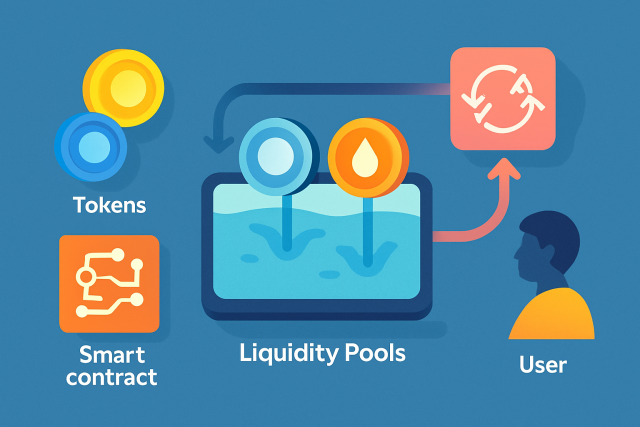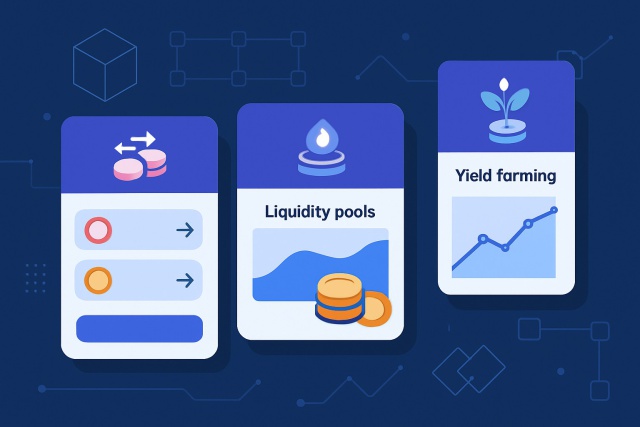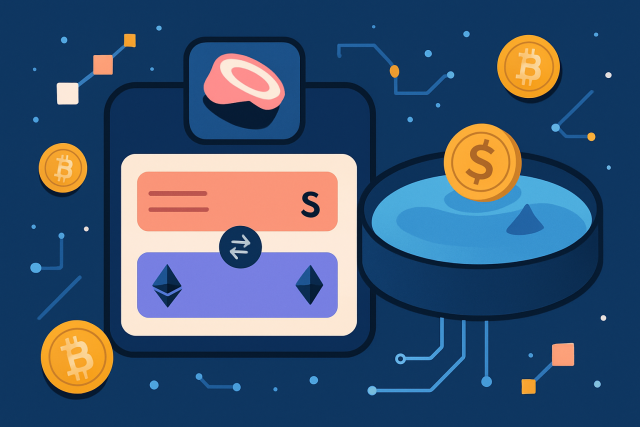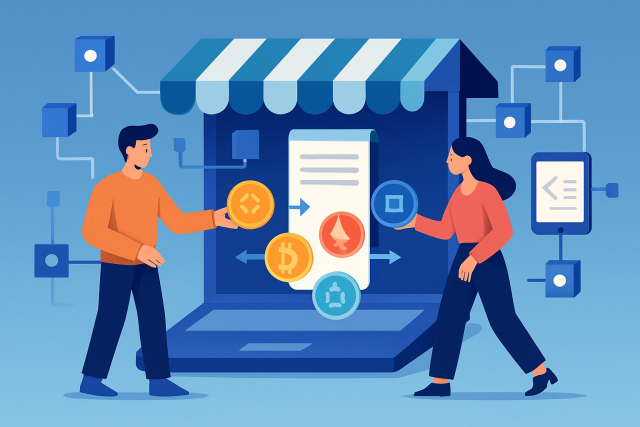Decentralized Exchange for Beginners

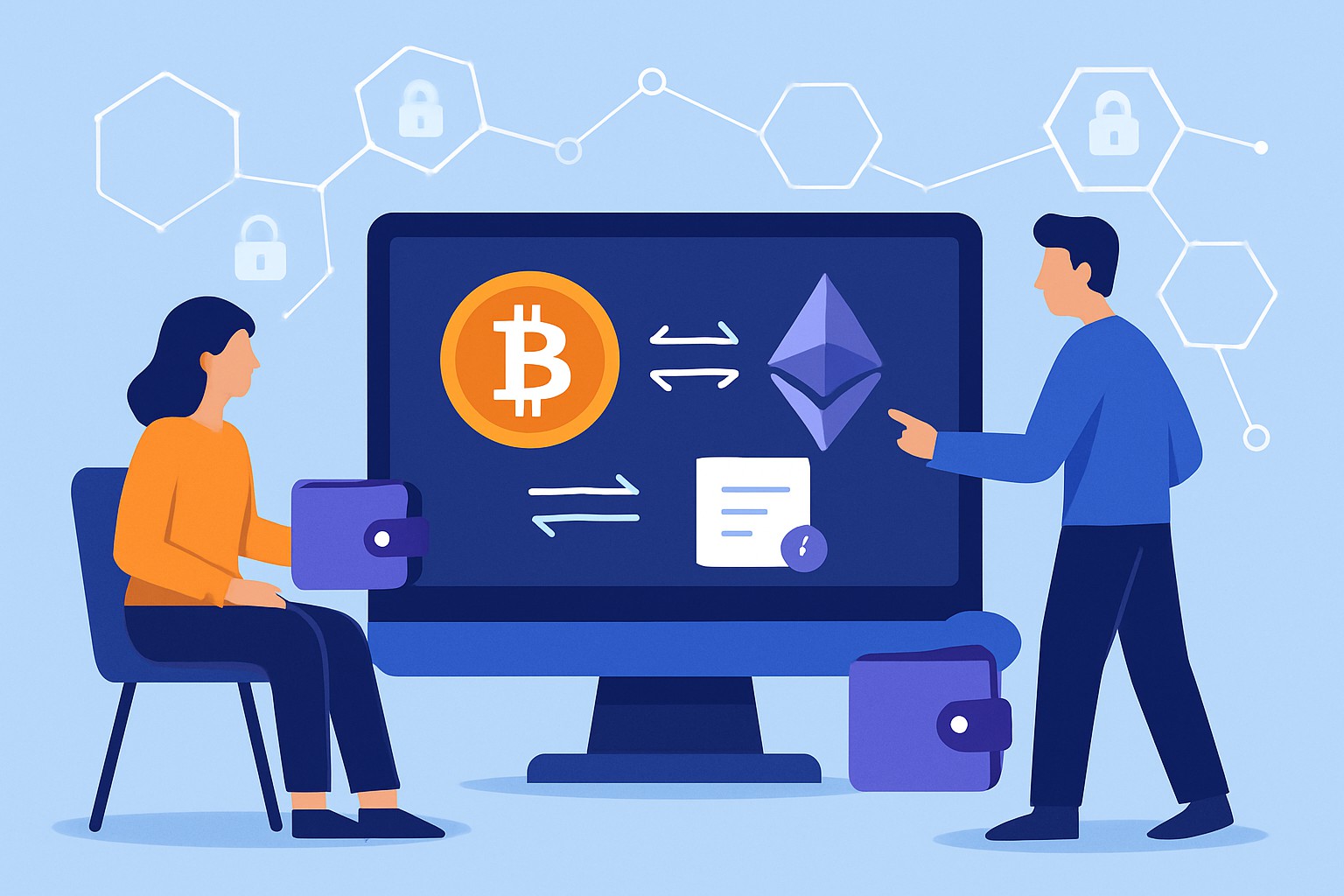
This guide breaks down decentralized exchanges for newcomers and reveals how they work, their perks and handy tips to keep your trading safe and sound.
- Get a handle on how DEXs let you trade crypto directly with others without middlemen so you stay in the driver’s seat with your funds and maintain your privacy.
- Dive into the world of decentralized exchanges to see how they tick and learn about smart contracts, liquidity pools and the transparent nature of blockchain transactions.
- Check out common types of DEXs from automated market makers to order book systems plus friendly tips on choosing the platform that suits your style.
- Learn to trade safely by locking down your wallet and watching for scams to make your DEX journey as secure as possible.
Decentralized exchanges (DEXs) are shaking up the way cryptocurrencies get traded by cutting out the middlemen.
What Exactly Is a Decentralized Exchange?
A decentralized exchange is a platform where crypto users can trade assets directly with each other without a middleman or central authority. Unlike centralized exchanges, DEXs run on blockchain technology and enable true peer-to-peer trading. They put users firmly in control of their private keys and funds.
- Security: Users stay firmly in the driver's seat when it comes to their own funds which cuts down the risk of hacks related to centralized custody.
- Privacy: Often, there is no need to hand over personal info or jump through KYC hoops which makes the process feel more low-key.
- No intermediaries: Trades happen straight up person to person with no middleman to complicate things.
- Transparency: Every transaction gets its moment in the spotlight on public blockchains so nothing sneaky slips through.
- Control over funds: Users hold the keys and the bag literally keeping full ownership of their private keys and assets.
How Decentralized Exchanges Actually Work A Closer Look Under the Hood
Decentralized exchanges use blockchain technology and smart contracts to handle trades automatically and cut out middlemen entirely. Automated Market Makers or AMMs depend on liquidity pools where users pitch in assets. This makes it possible to swap tokens quickly and securely on the blockchain.
- Smart contracts take care of trade execution automatically once specific conditions are met, like having a reliable sidekick that never misses a beat.
- Liquidity pools pull together user funds to make swaps happen smoothly, without the usual fuss of order books slowing things down.
- Token swaps let users flip cryptocurrencies in an instant—no waiting around, just quick and easy.
- User wallets hook up directly to the DEX, meaning users stay firmly in the driver’s seat when it comes to their funds.
- Every transaction plays out on-chain, which not only keeps everything transparent but also makes tampering virtually impossible.
| Feature | Centralized Exchanges | Decentralized Exchanges (DEXs) |
|---|---|---|
| Control | The exchange holds onto your funds, like handing over the keys | Users stay firmly in the driver’s seat, keeping full control of their own money |
| Security | Can sometimes be a sitting duck for hackers | Generally safer, thanks to their non-custodial setup that keeps your assets off one server |
| Fees | Usually lower but can swing depending on the platform | Includes gas fees plus some payments to liquidity providers, so costs can add up a bit |
| Speed | Trades usually go through quicker, cutting down your wait time | Largely depends on how fast the underlying blockchain is moving along |
| Accessibility | You will need to sign up and jump through KYC hoops | Typically open doors with no need to share personal info, making it pretty hassle-free |
A Quick Look at the Common Types of Decentralized Exchanges
Decentralized exchanges come in all shapes and sizes and each brings its own unique flavor to the table. The most common individuals probably know are AMM-based DEXs which use liquidity pools to make instant swaps happen smoothly. Then you have got order book-based DEXs which resemble the classic setups of traditional exchanges. To keep things interesting some platforms blend these two styles into hybrid models aiming to boost both efficiency and the user experience.
- Automated Market Makers like Uniswap and Sushiswap depend on liquidity pools to keep token swaps running smoothly, almost like the oil in a well-oiled machine.
- Order Book DEXs such as Stellar DEX stick to the classic order book style while proudly staying decentralized—old-school meets new rules.
- Hybrid DEXs like 0x Protocol cleverly blend the best of AMMs and order books to boost liquidity and make trade execution feel more seamless.
How to Get Started with a Decentralized Exchange A Friendly Guide to Taking the Leap
Beginners first need to set up a compatible crypto wallet, keep their private keys secure and then connect their wallet to a DEX platform.
Choose a wallet that fits your needs—MetaMask or Trust Wallet are great options—and set it up.
Keep your private keys and recovery phrases stored safely because losing them is like misplacing your house keys on a busy day.
Fund your wallet with cryptocurrency such as Ethereum or Binance Coin to get started.
Connect your wallet to the decentralized exchange platform you want to use, just like plugging in your headphones before the music starts.
Take some time to understand gas fees and transaction settings. They can be tricky, but knowing them will save you headaches later.
Tips for Trading Safely on a Decentralized Exchange
Trading on a decentralized exchange can feel a bit like the Wild West at times, but with the right know-how, you can navigate it smoothly. Here are some solid tips to keep you sailing safely through the seas of crypto swaps and trades.
Trading on DEXs carries a few risks you definitely want to keep on your radar. Always double-check those token addresses because it is the easiest way to avoid falling into a scam trap. When possible, stick to smart contracts that have been thoroughly audited since it is worth the extra peace of mind. Also, watch out for phishing attempts targeting your wallet and don’t forget to handle your privacy settings with care.
- Really dig into tokens before diving into trades and keep a close eye on the community vibe and whether the token has been audited. This small step can save a lot of headaches.
- Steer clear of shady links or phishing sites when hopping onto DEXs and instead bookmark the official URLs so you’re not caught off guard.
- Whenever you can, opt for hardware wallets to stash your assets because it provides an extra layer of security.
- Give your transaction details a good once-over. Double-check the recipient and fees before hitting that confirm button since mistakes often sneak in.
- Get familiar with slippage and set sensible limits because it helps avoid any surprises when your trade finally goes through.
In the decentralized space, careful due diligence is your number one ally. It’s absolutely key to double-check those smart contracts and keep your private keys under tight wraps — after all, your crypto security really depends on staying sharp and on your toes. – Blockchain Security Specialist
Expenses and Charges on Decentralized Exchanges You Really Need to Know
Understanding fee structures is important when diving into DEXs. Typically users pay gas fees for blockchain transactions and liquidity provider fees when they tap into pools. Then you have slippage costs which can change with market ups and downs.
| Fee Type | Description | Typical Range or Example |
|---|---|---|
| Gas Fees | Transaction fees you pay to miners or validators who keep the network humming | Varies with network traffic, usually somewhere between $5 and $50, give or take |
| Trading Fees | Charges liquidity providers sneak in when you swap tokens | Typically about 0.3% per trade on AMM platforms, nothing shocking |
| Slippage Impact | The annoying difference between the price you expect and what you actually end up paying | Can swing anywhere from 0.1% to 5%, depending on how much liquidity is available |
| Liquidity Provider Fees | The slice of trading fees that goes straight to those who provide liquidity | Usually baked into the overall 0.3% trading fee, so you don’t see it separately |
The Pros and Cons of Decentralized Exchanges
Let’s dive into the nitty-gritty of decentralized exchanges, or DEXs for short. They’ve become quite the talk of the town in the crypto world, promising more freedom and control—but as with anything worth its salt, they come with their own set of quirks and challenges. Whether you’re a seasoned trader or just crypto-curious, understanding the ups and downs of DEXs can help you navigate this sometimes wild frontier with a bit more confidence and a touch less head-scratching.
Decentralized exchanges offer a solid shield against censorship and give you better privacy while putting real control over your funds in your hands. However, they can struggle with lower liquidity compared to their centralized cousins. They might feel daunting if you’re just starting out and tend to charge steeper fees when networks get busy.
- Benefit: They’re pretty good at dodging censorship and shutdowns from governments or companies which is a breath of fresh air in today’s climate.
- Benefit: Privacy tends to be well-preserved since many DEXs don’t ask users to jump through the usual identity verification hoops.
- Benefit: Users get to hold the reins maintaining full control and ownership of their own assets—no middlemen breathing down your neck.
- Limitation: Liquidity can be a bit thin which sometimes leads to those unwelcome bigger price swings.
- Limitation: The complexity might scare off newcomers who haven’t quite wrapped their heads around blockchain tech yet.
- Limitation: Network congestion can sneak up and cause higher fees alongside slower transaction times making patience a virtue here.
Advanced Features and Emerging Trends in the Ever-Evolving World of Decentralized Exchanges
Decentralized exchanges have been steadily evolving, rolling out features like yield farming and liquidity mining to sweeten the deal and encourage users to chip in liquidity. Cross-chain DEXs are busy breaking down walls to boost interoperability, while layer 2 scaling solutions zero in on slashing fees and cranking up the speed.
- Layer 2 scaling solutions like Optimism and Arbitrum usually slash transaction costs and speed things up, making the whole process smoother.
- Thanks to cross-chain interoperability, assets can glide across different blockchains which is a game changer for fluid movement.
- Decentralized governance tokens hand over voting rights to users giving them a real say in platform upgrades and policies—it's democracy in action blockchain style.
- When these systems integrate with broader DeFi protocols it opens the door to greater composability and lets developers create more sophisticated financial products than ever before.

Getting Started with a Simple Action Plan for Beginners
Kick things off by exploring decentralized exchange platforms that meet your needs and support the assets you want to trade because not all platforms are created equal.
Next up, set up a secure cryptocurrency wallet. Hardware wallets usually offer the level of protection that’s worth the extra peace of mind.
Make sure you fully understand how to manage and back up your wallet's private keys and recovery phrases safely. This step is easy to overlook but can save you a lot of trouble later on.
Start trading with small amounts to get comfortable with how the platform works and to monitor those pesky fees.
When you feel ready, try out more advanced features like staking and liquidity provision. These can boost your earnings and engagement if you are up for it.
Getting the hang of decentralized exchanges opens the door to greater financial freedom, putting you firmly in the driver's seat when it comes to your assets.
Frequently Asked Questions
How do I choose the best decentralized exchange for my needs?
It helps to weigh factors like which assets are supported, liquidity levels, fees and how user-friendly the platform feels. Beginners often find AMM-based DEXs like Uniswap a gentle place to start. More seasoned traders might lean toward hybrid models. Before connecting your wallet, it’s wise to check the platform’s security audits and see what the community buzz is about.
Are decentralized exchanges really safer than centralized ones?
DEXs sidestep centralized custody headaches like exchange hacks and put you fully in control of security. Your funds stay in your wallet so keeping private keys safe is key. Watch out for phishing scams as well. Smart contract bugs can still cause problems so it’s best to use platforms audited thoroughly.
Why are gas fees sometimes so high on DEXs?
Gas fees ebb and flow with network traffic. The busier it gets, the steeper the fees climb. Ethereum-based DEXs feel like rush hour during peak times. If fees break your budget, especially for smaller trades, consider Layer 2 solutions or other blockchains where costs are lower.
What is the biggest mistake beginners make when first using a DEX?
A common pitfall is not double-checking token contract addresses which leads to scam tokens. Always cross-reference official token websites and check blockchain explorers before trading. Setting slippage tolerance incorrectly is another error that can cause trades to go sideways when markets are volatile.
Can I use a decentralized exchange completely anonymously?
Most DEXs don’t ask for KYC and let you trade under your wallet address without giving personal info. However, blockchain analysis can sometimes link activity back to real identities especially if you cash out to fiat currency. For extra privacy, use privacy-centric chains and avoid linking your personal wallet addresses.
How can I provide liquidity to a DEX and is it worth it?
You provide liquidity by depositing equal parts of two tokens into a pool. This earns you trading fees and often extra rewards. While it can pay off, watch the risks like impermanent loss and pool popularity. Starting small with stablecoin pairs is usually smart before investing bigger amounts.


